If you’re looking to add character and charm to your living space, industrial style interior design may be the perfect fit for you. Inspired by the raw, unfinished look of industrial buildings, this style celebrates the beauty of exposed pipes, concrete, and metal. It’s a style that’s both functional and stylish, with a focus on simplicity and minimalism.
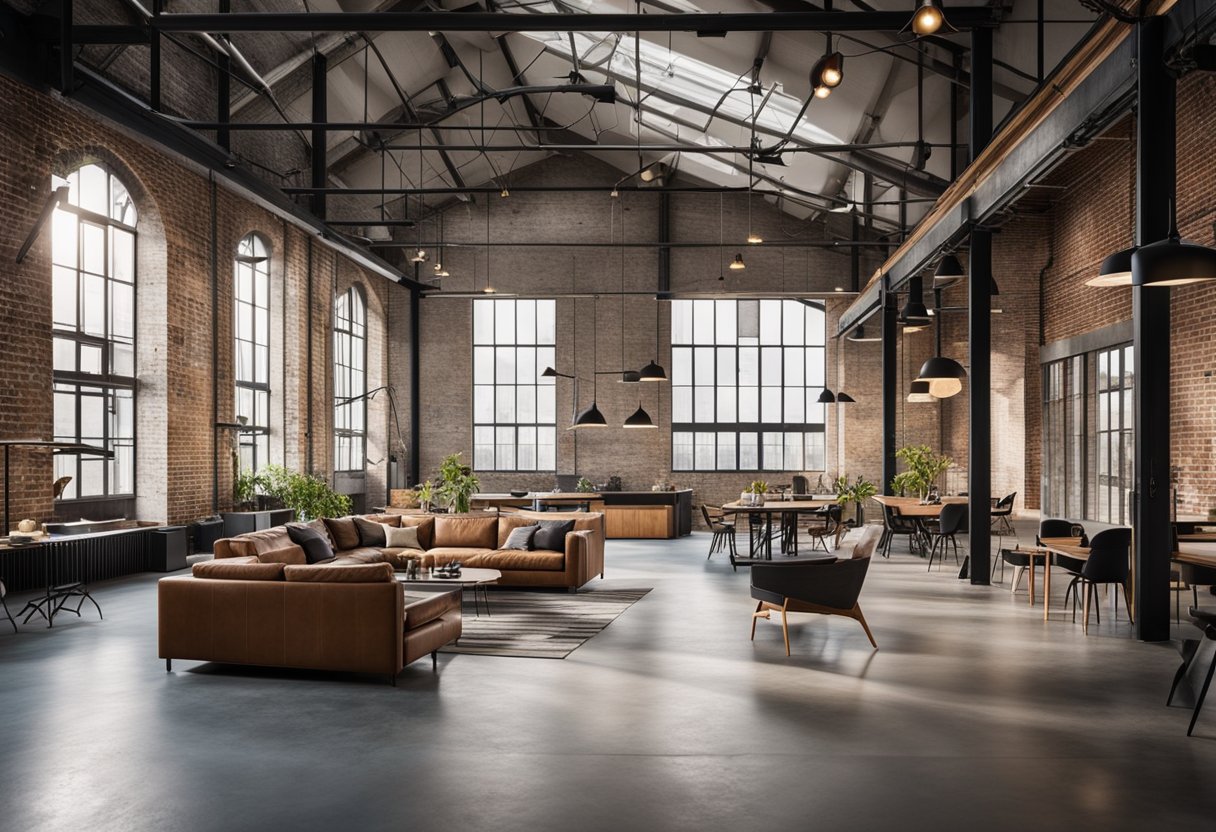
Industrial style interior design has been around for decades, but it has gained popularity in recent years as more people look for unique and unconventional ways to decorate their homes. It’s a style that’s all about embracing the beauty in imperfection, with a focus on creating a space that’s both functional and aesthetically pleasing. Whether you’re renovating a loft or just want to add a touch of industrial style to your living room, this design style is sure to make a statement.
Key Takeaways
- Industrial style interior design celebrates the beauty of raw, unfinished materials such as concrete and metal.
- This design style is both functional and stylish, with a focus on simplicity and minimalism.
- Industrial style has gained popularity in recent years as more people look for unique and unconventional ways to decorate their homes.
Historical Context and Evolution

If you’re interested in interior design, you’ve probably heard of the industrial style. This style has become increasingly popular in recent years, and it’s not hard to see why. It’s a style that’s both functional and stylish, and it’s perfect for those who want to create a unique and interesting space in their home or office.
Origins of Industrial Style
The origins of industrial style can be traced back to the industrial revolution, which began in the late 18th century. During this time, old factories and warehouses began to surface across Europe and the United States, featuring large, open spaces with utilitarian materials such as exposed brick, steel, and concrete.
These buildings were designed for functionality rather than aesthetics, but over time, people began to appreciate the beauty of their simplicity. The industrial style emerged as a way to bring this aesthetic into homes and other spaces.
Influence of the Industrial Revolution
The industrial revolution had a profound impact on design aesthetics, and it’s no surprise that it played a key role in the development of the industrial style. The focus on functionality and efficiency that was so important during this time is reflected in the clean lines and simple materials that are characteristic of the industrial style.
In addition to the influence of the industrial revolution, the popularity of the industrial style can also be attributed to the fact that it’s a style that’s easy to achieve. With a few simple materials and a bit of creativity, you can create a space that’s both functional and stylish.
Overall, the industrial style is a great way to add a unique and interesting touch to your space. Whether you’re looking to create an industrial-inspired home or office, this style is sure to impress.
Design Principles
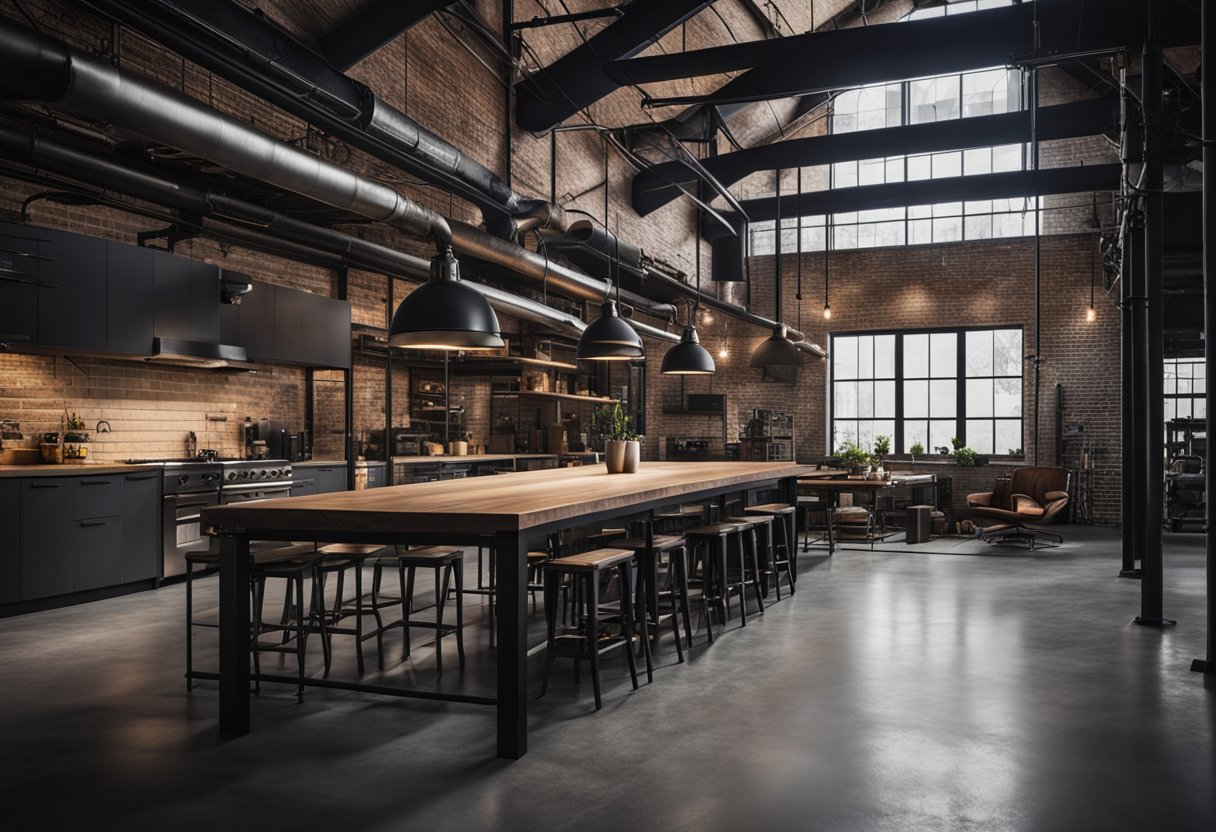
When it comes to industrial style interior design, there are a few key principles that you should keep in mind to achieve the desired effect. In this section, we’ll explore some of the most important design principles that you should consider when creating an industrial-style space.
Embracing Raw Materials
One of the defining characteristics of industrial style interior design is the use of raw materials. This means incorporating materials like metal, concrete, and brick into your space, and leaving them exposed rather than covering them up. By embracing these raw materials, you can create a space that feels authentic, rugged, and full of character.
Focus on Functionality
Another key aspect of industrial style interior design is functionality. Industrial spaces are typically designed to be practical and efficient, with a focus on getting the job done. To achieve this effect in your own space, you should prioritize functionality when selecting furniture and decor. Look for pieces that are sturdy, durable, and designed to serve a specific purpose.
Minimalism and Open Space
Finally, industrial style interior design is characterized by minimalism and open space. This means avoiding clutter and unnecessary decoration, and instead focusing on clean lines and an open layout. By keeping your space simple and uncluttered, you can create a sense of calm and serenity that is perfect for industrial style interiors.
Overall, industrial style interior design is all about embracing raw materials, prioritizing functionality, and keeping things simple and uncluttered. By following these design principles, you can create a space that is both stylish and practical, and that perfectly captures the rugged, authentic feel of industrial design.
Key Elements of Industrial Style
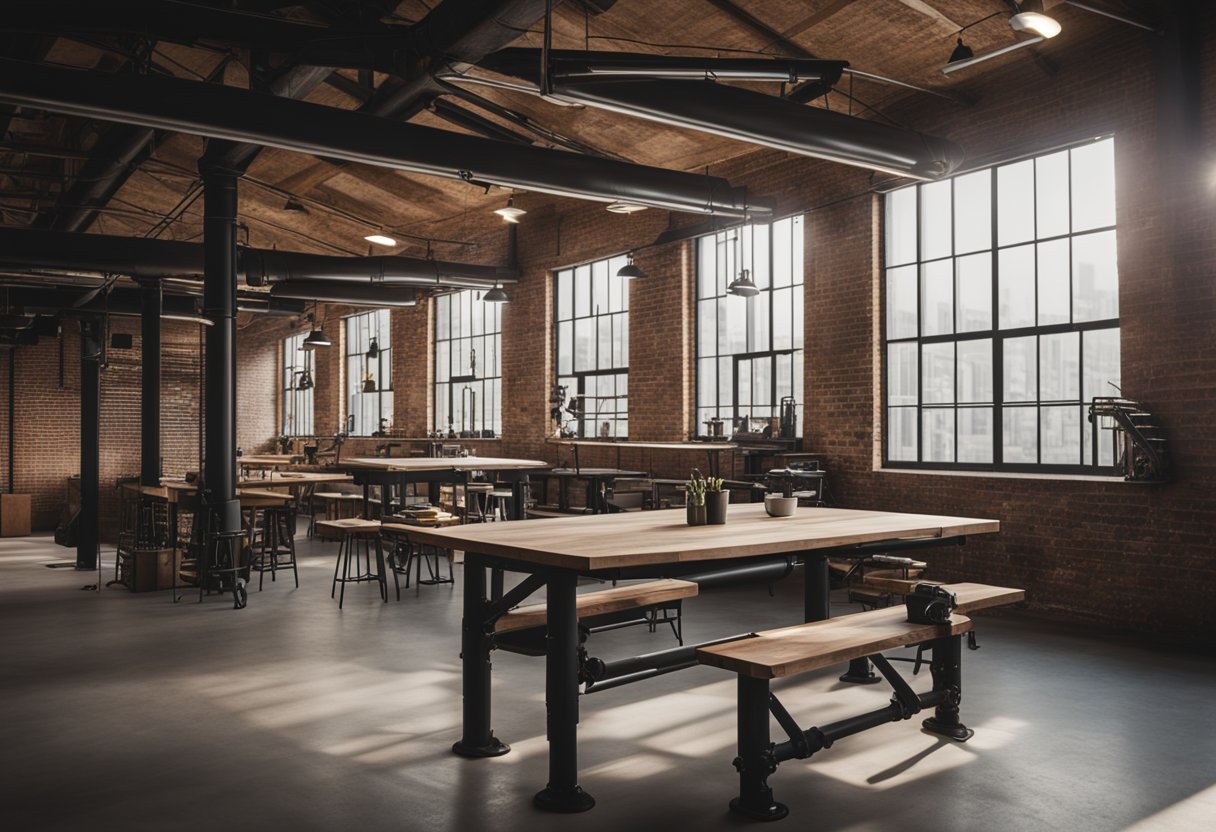
When it comes to industrial style interior design, there are several key elements that define this style. These elements include structural features, materials and textures, and color palette and lighting.
Structural Features
One of the most significant features of industrial style interior design is the use of structural elements. High ceilings, exposed beams, and ducts are common in industrial-style homes. The use of these elements adds a sense of openness and spaciousness to the space.
Materials and Textures
Industrial style interior design is all about using raw, natural materials and textures. Materials such as steel, concrete, brick, and wood are commonly used in industrial-style homes. These materials are often left in their natural state, without any additional finishes or treatments. The use of these materials adds a sense of authenticity and ruggedness to the space.
Textures also play a significant role in industrial style interior design. Rough textures like exposed brick and concrete walls, as well as smooth textures like metal and glass, are commonly used to add depth and interest to the space.
Color Palette and Lighting
Industrial style interior design typically uses a neutral color palette. Shades of grey, black, and white are commonly used, with hints of darker tones for a moodier look. The use of a neutral color palette allows the raw materials and textures to take center stage.
Lighting is also an essential element of industrial style interior design. Industrial-style lighting, such as pendant lights, is commonly used to add interest and depth to the space. The use of exposed bulbs and fixtures adds to the raw, industrial feel of the space.
In conclusion, industrial style interior design is all about using raw, natural materials and textures, incorporating structural elements like high ceilings and exposed beams, and using a neutral color palette with moody accents. By incorporating these key elements into your space, you can create a rugged, authentic, and exciting industrial-style home.
Furniture and Decor
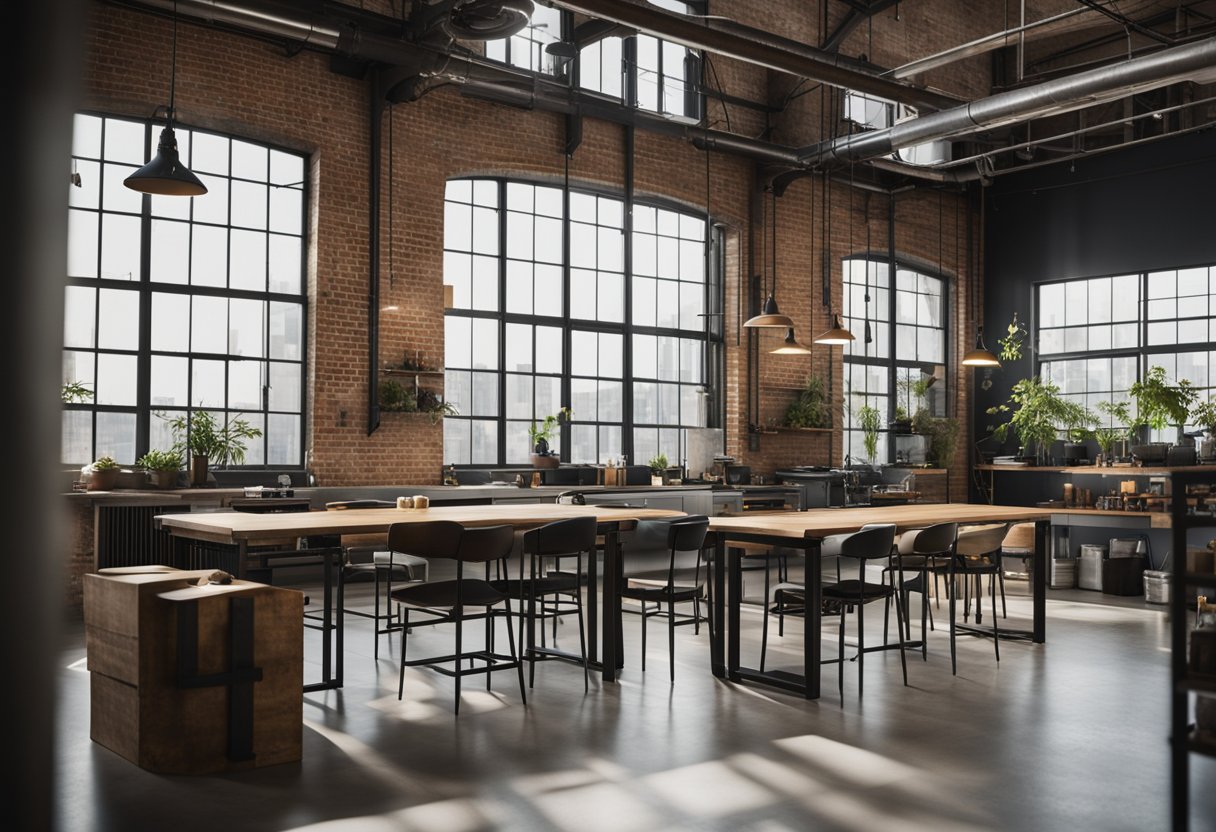
When it comes to industrial style interior design, furniture and decor play a crucial role in achieving the desired look. Here are some tips to help you choose the right furniture and decor for your industrial-inspired space.
Choosing Industrial Furniture
Industrial furniture is a key element of the industrial style. When selecting furniture, look for pieces that are made from materials such as metal, leather, and distressed wood. Wrought iron is also a popular choice for industrial furniture, as it adds a rustic touch to the space.
Consider incorporating furniture pieces that have a raw, unfinished look. This could include tables with exposed hardware or chairs with visible welding marks. These imperfections add character and authenticity to the space.
Accessorising with Artwork and Decor
Artwork and decor can add an extra layer of personality to your industrial-inspired space. When selecting artwork, consider abstract paintings or prints that incorporate metal accents or industrial elements. Canvas prints of vintage machinery or factory scenes can also work well.
In terms of decor, look for pieces that have an industrial feel. This could include metal sculptures, vintage signs, or even repurposed industrial machinery. Don’t be afraid to mix and match different textures and materials to create a visually interesting space.
Overall, choosing the right furniture and decor is key to achieving an industrial style interior design. By incorporating industrial elements such as distressed wood, metal accents, and abstract art, you can create a space that is both functional and visually appealing.
Industrial Style in Different Spaces
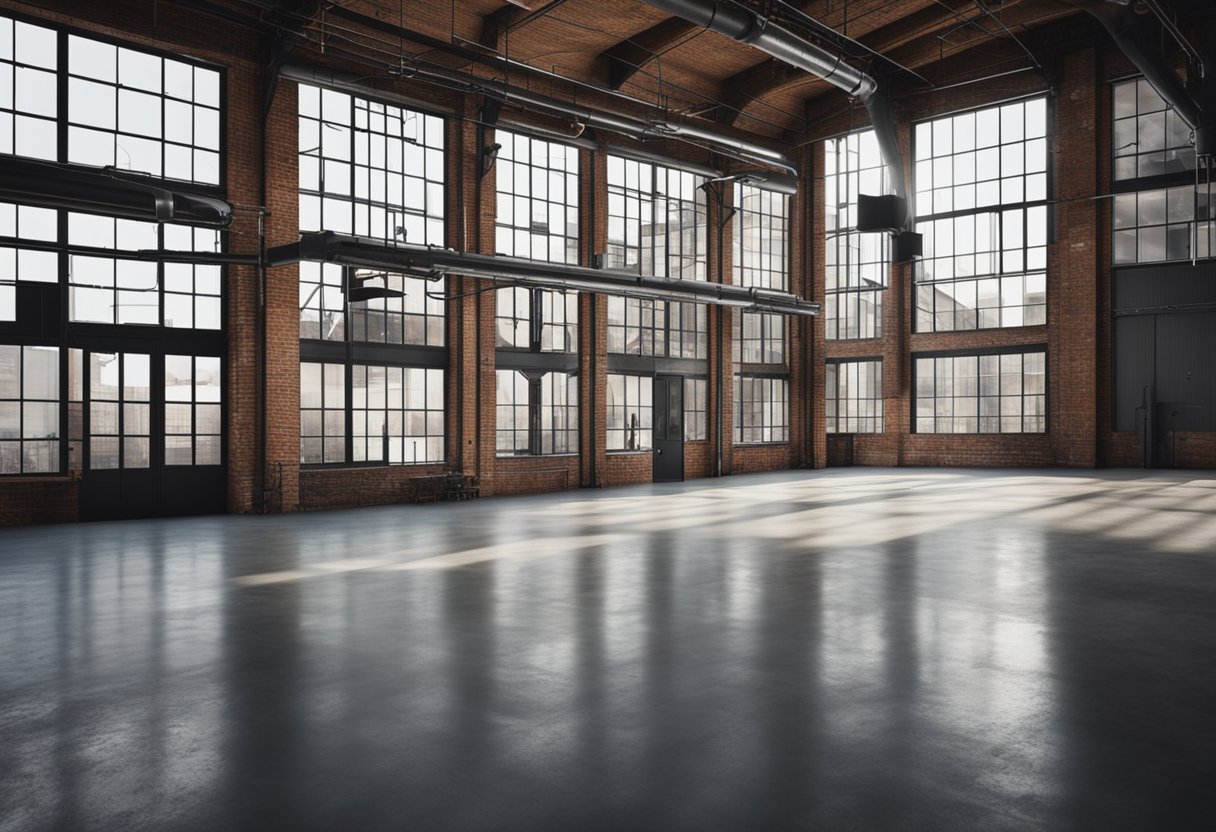
If you’re looking to incorporate industrial style into your home or office, there are a variety of spaces where this design style can work well. Here are a few ideas to get you started:
Living Room Design
The living room is often the heart of the home, and it’s a great space to experiment with industrial style. One way to incorporate this style into your living room is by using raw materials like metal and wood. Consider using an industrial-style coffee table or shelving unit made from reclaimed wood and metal pipes. You can also add industrial lighting fixtures like metal pendant lights or exposed bulb fixtures to complete the look.
Kitchen Design
Kitchens are another space where industrial style can work well. Industrial kitchens often feature stainless steel appliances, concrete countertops, and open shelving. If you’re looking to add some industrial style to your kitchen, consider incorporating these elements into your design. You can also add industrial-style lighting fixtures like metal pendant lights or Edison bulb fixtures to create a cohesive look.
Industrial Style Offices
Industrial style can also work well in commercial spaces like offices. If you’re looking to create an industrial-style office, consider using materials like exposed brick, concrete, and metal. You can also incorporate industrial-style lighting fixtures like metal pendant lights or exposed bulb fixtures. Industrial-style furniture like metal desks and chairs can also help to complete the look.
Incorporating industrial style into your home or office can be a fun and exciting design challenge. By using raw materials, industrial lighting fixtures, and industrial-style furniture, you can create a unique and stylish space that is both functional and beautiful.
Incorporating Contemporary Influences
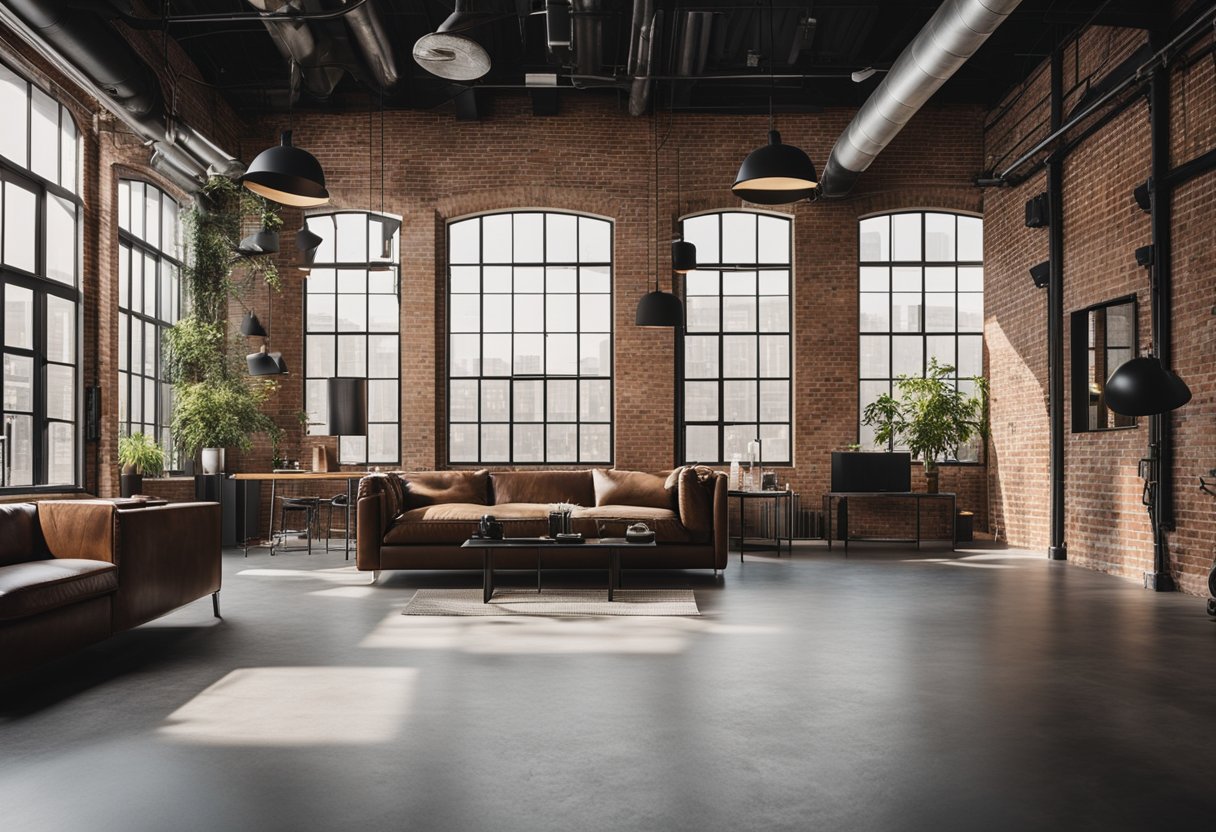
If you’re looking to incorporate some contemporary influences into your industrial-style interior design, you’re in luck! There are a variety of ways to add a modern touch to your space while still maintaining the edgy, stylish aesthetic that makes industrial design so popular.
Modern Industrial Design
One way to add a contemporary twist to your industrial-style space is to incorporate elements of modern industrial design. This style takes the raw, utilitarian aesthetic of traditional industrial design and adds sleek, minimalist touches to create a more refined look.
To achieve this style, focus on incorporating clean lines, neutral colours, and pops of metallic accents. Consider adding modern lighting fixtures, such as pendant lights with geometric shapes or sleek, minimalist floor lamps. You can also incorporate modern furniture pieces, like a sleek leather sofa or a minimalist coffee table.
Scandinavian and Hygge Elements
Another way to add a contemporary touch to your industrial-style space is to incorporate elements of Scandinavian design and hygge. These styles focus on creating a cosy, inviting atmosphere that’s perfect for relaxing and unwinding.
To achieve this look, focus on incorporating warm, natural materials like wood and textiles. Add soft, plush rugs or throws to your space, and consider incorporating plants or other natural elements to bring a touch of nature indoors. You can also add pops of colour with throw pillows or artwork to create a more inviting, cosy atmosphere.
Overall, incorporating contemporary influences into your industrial-style interior design is a great way to create a space that’s both stylish and cosy. Whether you opt for modern industrial design or elements of Scandinavian and hygge, there are plenty of ways to add a contemporary touch to your space without sacrificing the edgy, utilitarian aesthetic that makes industrial design so unique.
Unique Features and Personal Touches
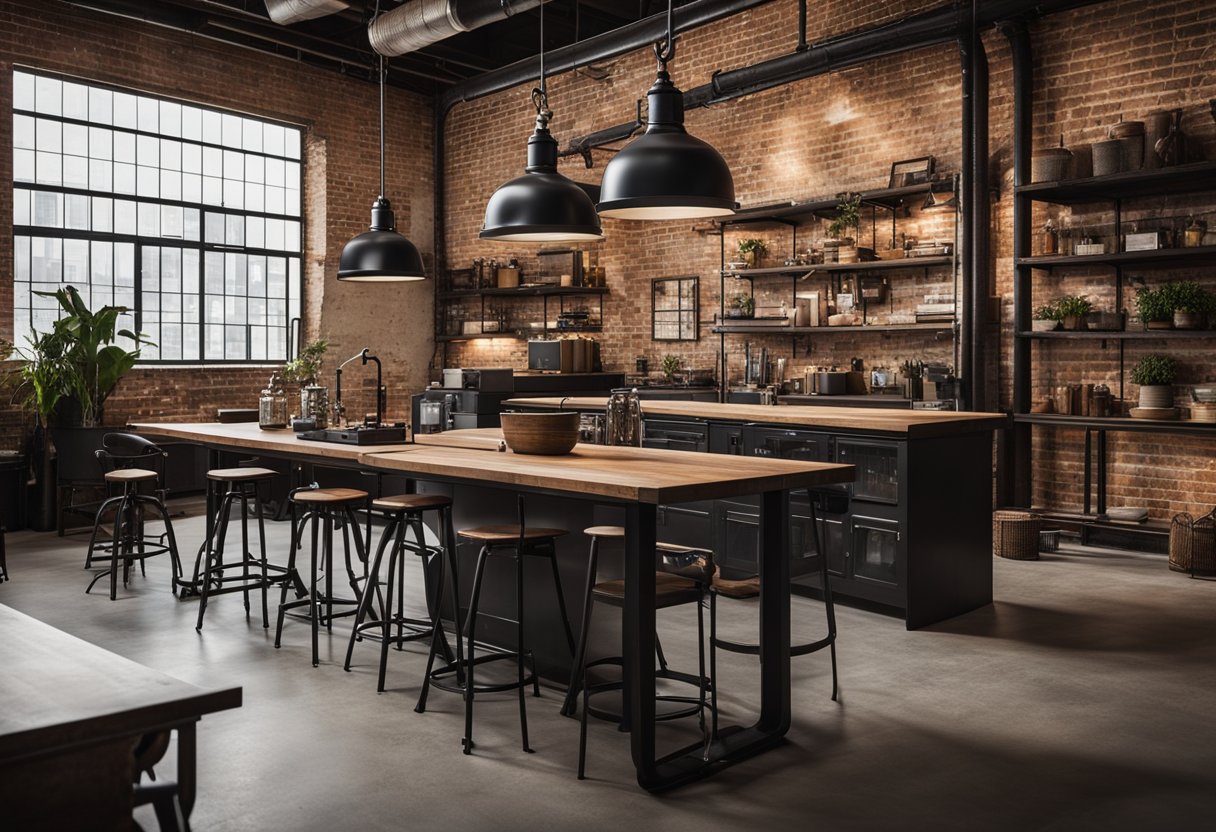
When it comes to industrial style interior design, there are plenty of unique features and personal touches you can add to make your space truly your own. Here are some ideas to get you started:
Customisation and DIY
One of the best things about industrial style interior design is that it lends itself well to customisation and DIY projects. Whether you’re repurposing old materials or creating something entirely new, there are plenty of ways to add your own personal touch to your space.
For example, consider using reclaimed wood to create a unique feature wall or to build custom furniture pieces. You could also try your hand at painting or distressing furniture to give it a more rustic, industrial feel.
Adding Character and Authenticity
Another key aspect of industrial style interior design is adding character and authenticity to your space. This can be achieved in a number of ways, such as:
- Exposed brick walls: If your space has brick walls, consider leaving them exposed rather than covering them up. This can add a lot of character and warmth to your space.
- Large windows: Industrial style interior design often features large windows that let in plenty of natural light. If your space doesn’t have large windows, consider adding some to create a brighter, more open feel.
- Industrial-style lighting: Lighting is a key component of industrial style interior design. Look for fixtures that have an industrial feel, such as pendant lights made from metal or glass.
- Unfinished elements: Unfinished elements such as concrete floors or wooden beams can add a lot of character to your space. Consider leaving these elements exposed rather than covering them up.
By incorporating these unique features and personal touches into your industrial style interior design, you can create a space that is truly one-of-a-kind.
Challenges and Considerations
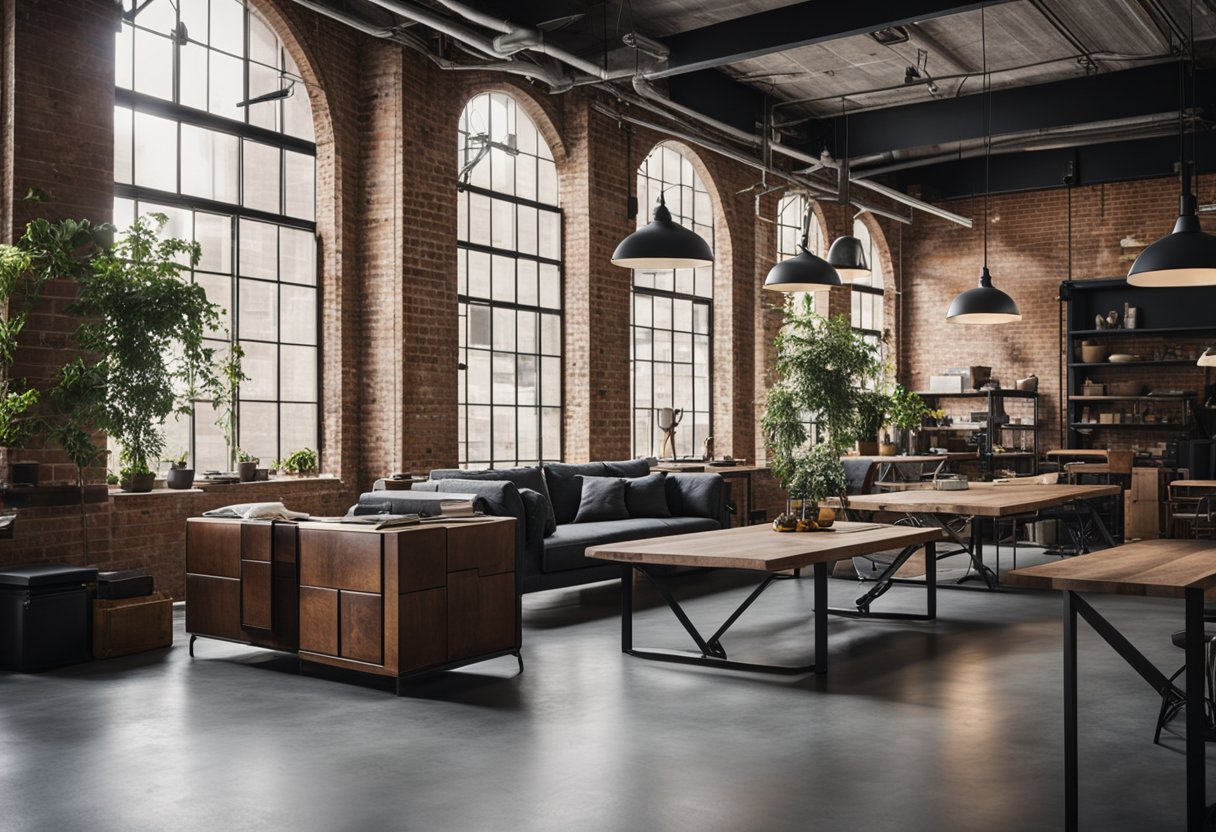
When it comes to designing an industrial-style interior, there are a few challenges and considerations that you need to keep in mind. In this section, we’ll discuss two of the most important ones: maintaining balance and comfort, and navigating building regulations.
Maintaining Balance and Comfort
One of the biggest challenges of industrial-style interior design is maintaining a balance between the raw, edgy aesthetic of the style and the need for comfort and coziness in a living space. While the industrial style is all about exposed materials, harsh lines, and minimalism, it’s important to remember that your home is still a place where you need to feel comfortable and relaxed.
To achieve this balance, consider incorporating soft textures and warm colours into your design. Think about adding plush rugs, comfortable seating, and cosy throws to soften the hard edges of the industrial style. You could also use lighting to create a warm and inviting atmosphere, with soft, warm light bulbs and dimmer switches.
Navigating Building Regulations
Another consideration when designing an industrial-style interior is navigating building regulations. In Singapore, there are strict regulations when it comes to building and renovation, and you need to make sure that your design complies with these regulations.
Before you start your project, make sure you do your research and find out what permits and approvals you need to obtain. You may need to work with a professional architect or designer who has experience navigating these regulations to ensure that your design is both safe and legal.
Overall, designing an industrial-style interior can be a fun and exciting project, but it’s important to keep in mind the challenges and considerations that come with the style. By maintaining a balance between raw aesthetics and comfort, and navigating building regulations, you can create a beautiful and functional industrial-style interior that you’ll love to live in.
Global Trends and Local Adaptations
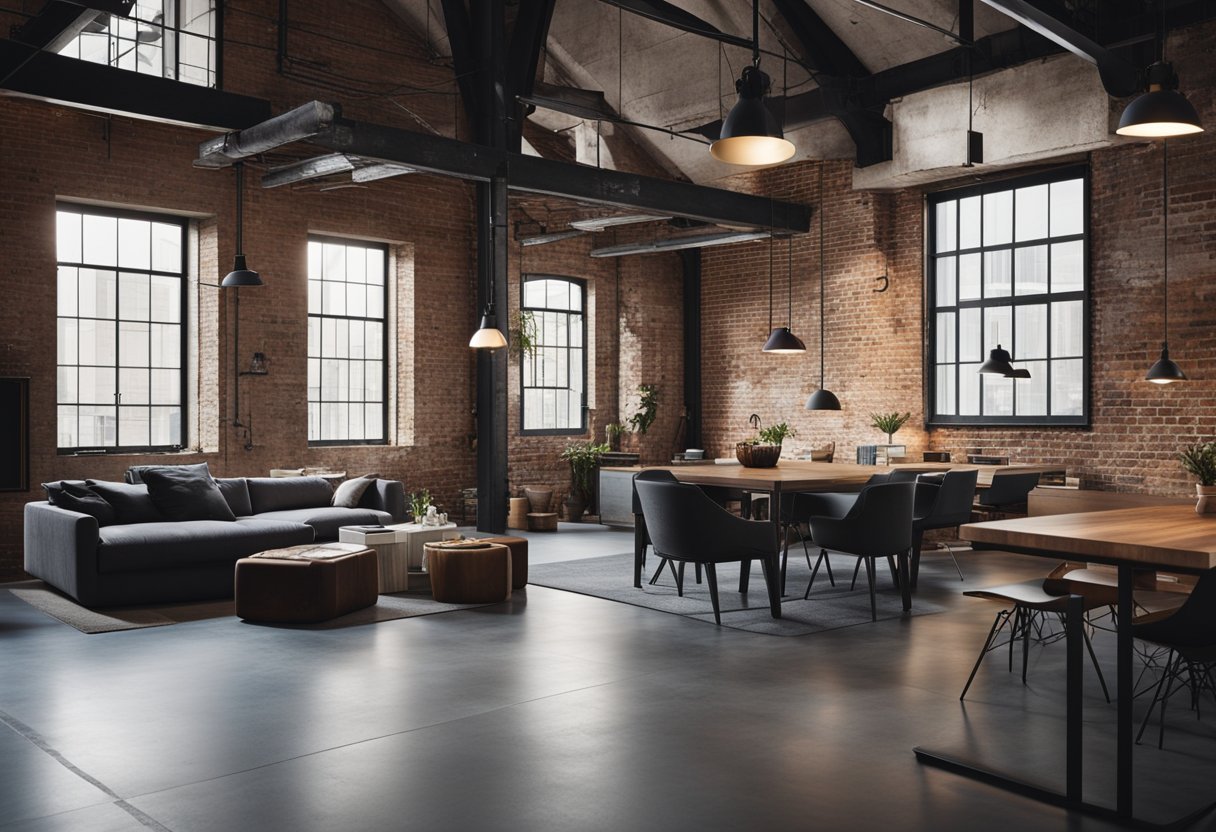
When it comes to industrial style interior design, there are global trends that are followed by designers all around the world. However, each location has its own unique culture and environment, which leads to local adaptations of the industrial style. Let’s take a closer look at how industrial style is being adapted in Singapore and worldwide.
Industrial Style in Singapore
Singapore is known for being a modern, cosmopolitan city, and this is reflected in its industrial style interior design. Designers in Singapore often combine elements of industrial style with modern and minimalist design to create a unique look. For example, they may use concrete floors and exposed pipes, but also incorporate sleek, contemporary furniture and lighting.
One of the key features of industrial style in Singapore is the use of raw materials. Designers often leave materials such as concrete, steel, and brick exposed, rather than covering them up with plaster or paint. This creates a raw, unfinished look that is both edgy and stylish.
Adapting Industrial Design Worldwide
While there are global trends in industrial style interior design, each location has its own unique culture and environment that affects how the style is adapted. For example, in Europe, designers often incorporate vintage and antique elements into their industrial style designs, such as old factory machinery or salvaged wood.
In Asia, designers may focus more on creating a sense of space and openness, using large windows and open floor plans to create a feeling of airiness and lightness. In North America, designers may incorporate more rustic elements into their industrial style designs, such as reclaimed wood and distressed finishes.
Overall, industrial style interior design is a versatile and adaptable style that can be tailored to fit any location or culture. Whether you’re in Singapore or anywhere else in the world, there are endless possibilities for creating a unique and stylish industrial style interior design that reflects your personal taste and style.
Professional Guidance
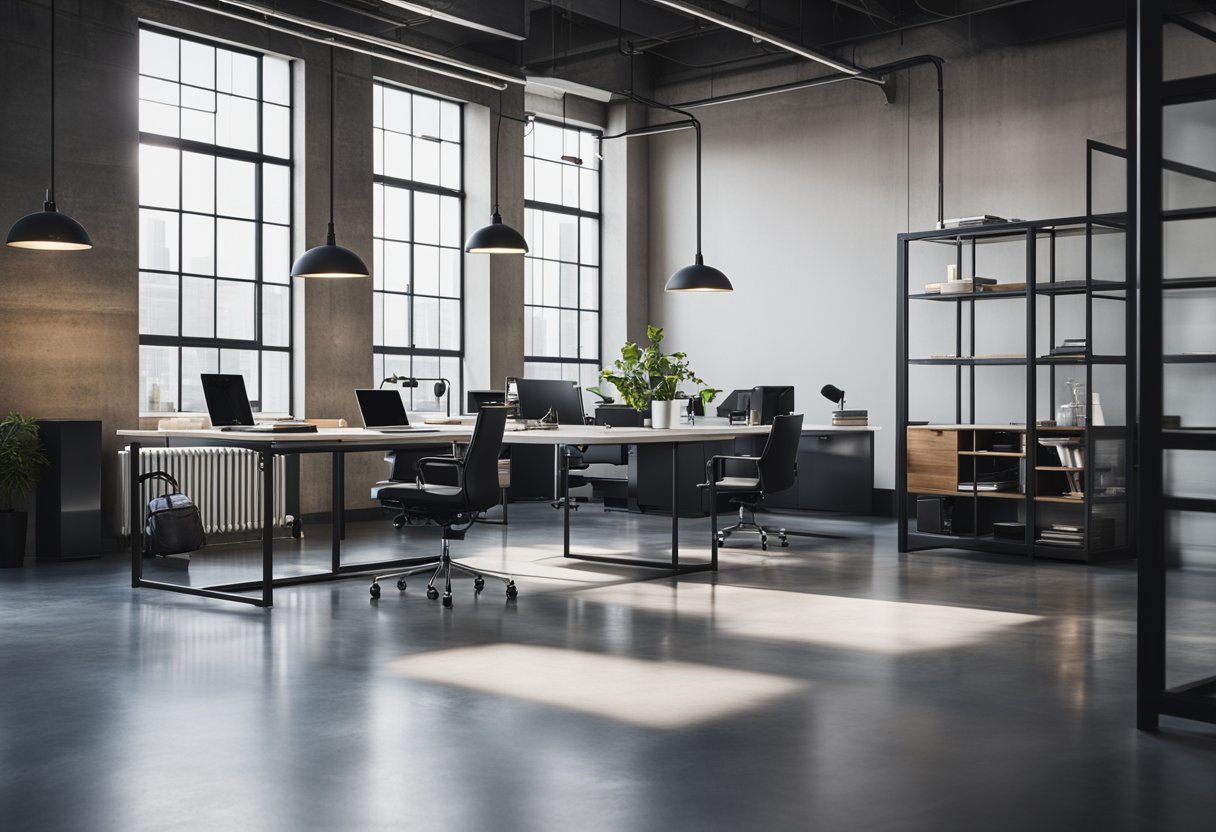
If you’re considering an industrial style interior design for your home or office, working with an interior designer can be incredibly helpful. Interior designers can help you create a cohesive look that fits your personal style and needs, while also ensuring that the design is functional and practical.
Working with Interior Designers
When working with an interior designer, it’s important to communicate your vision and goals clearly. Be open to their suggestions and ideas, but also make sure that you’re comfortable with the direction they’re taking the design.
Interior designers can help you select the right materials and colours for your space, as well as choose furniture and lighting that complements the overall design. They can also help you incorporate industrial-inspired design ideas into various rooms in your home or office.
Working with an interior designer can also help you save time and money. They have access to a wide range of resources and can help you find the best deals on materials and furniture. They can also help you avoid costly mistakes by ensuring that the design is functional and practical.
Overall, working with an interior designer can help you achieve the industrial style interior design that you’re looking for, while also ensuring that the design is practical and functional.
Sustainability and Industrial Style

If you’re looking to create an industrial style interior with sustainability in mind, there are many ways to achieve this. The industrial style is already known for its use of raw and natural materials, which can be eco-friendly if sourced correctly. Here are some ways to incorporate sustainability into your industrial style interior design:
Eco-Friendly Materials and Practices
When it comes to eco-friendly materials, reclaimed wood is a great option for industrial style interiors. Reclaimed wood is wood that has been salvaged from old buildings, factories, or warehouses. This wood can be repurposed into furniture, flooring, or accent pieces, giving your space a unique and sustainable touch.
Another eco-friendly option is to use recycled or upcycled materials for your decor. For example, you can use old metal pipes as curtain rods or shelving brackets. This not only adds to the industrial aesthetic but also reduces waste.
In addition to using eco-friendly materials, it’s important to consider sustainable practices. For example, you can install energy-efficient lighting, such as LED bulbs, to reduce your energy consumption. You can also use natural ventilation and insulation to reduce your reliance on heating and cooling systems.
By incorporating these eco-friendly materials and practices into your industrial style interior design, you can create a space that is not only stylish but also sustainable.
Future of Industrial Style
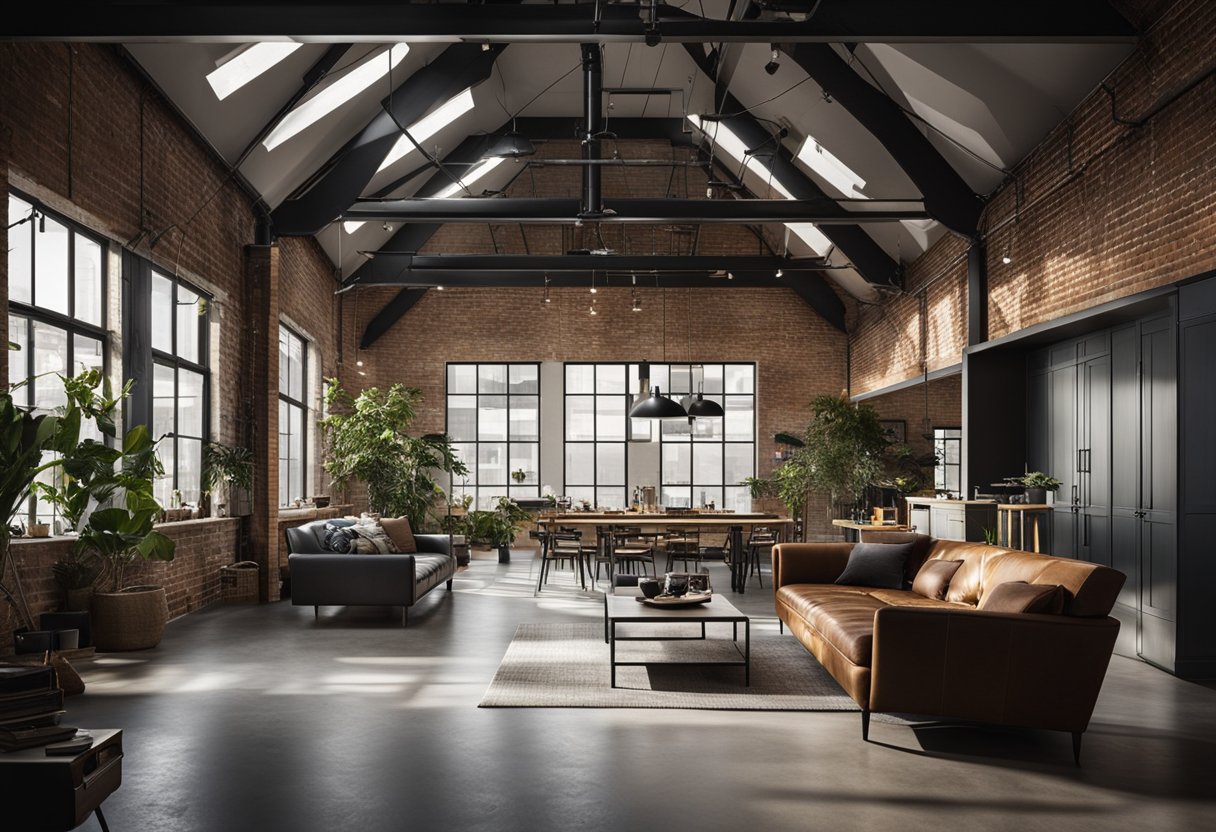
As you look to the future of industrial style, you can expect to see a continuation of the trend towards a more refined and polished look. Emerging trends in industrial design are likely to incorporate more natural materials, such as wood and stone, along with the traditional metal and concrete.
Emerging Trends in Industrial Design
One of the most exciting emerging trends in industrial design is the use of sustainable materials. As more and more people become aware of the impact that their choices have on the environment, designers are responding by incorporating eco-friendly materials into their designs. This can include everything from reclaimed wood to recycled metal.
Another trend that is likely to continue is the use of technology in industrial design. As smart home technology becomes more prevalent, you can expect to see more and more industrial style designs that incorporate technology seamlessly into the overall aesthetic. This could include everything from smart lighting systems to automated window shades.
Finally, you can expect to see a continued focus on functionality in industrial design. While the style is certainly aesthetically pleasing, it is also highly functional. As people continue to look for ways to maximize the use of their space, industrial style designs that incorporate clever storage solutions and multi-functional furniture are likely to become even more popular.
Overall, the future of industrial style is bright and exciting. With a focus on sustainability, technology, and functionality, you can expect to see even more beautiful and functional industrial style designs in the years to come.
Conclusion
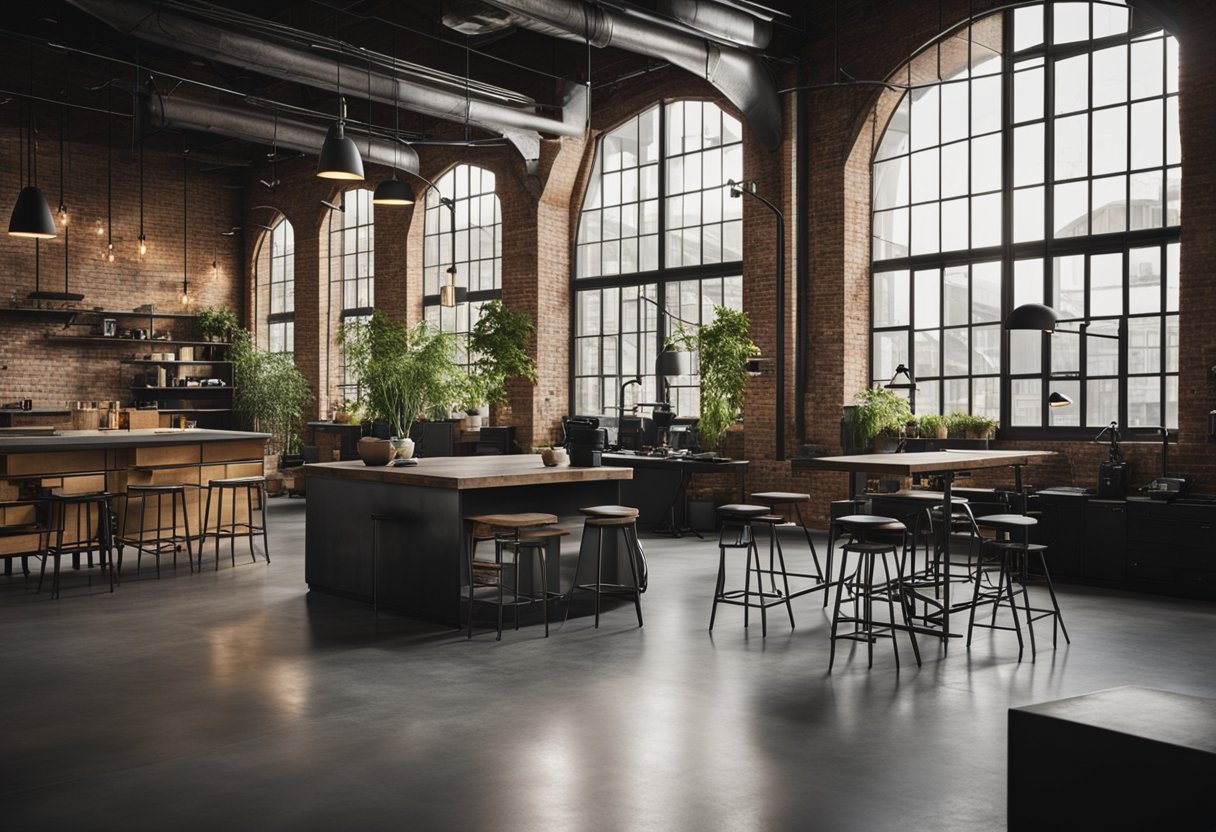
Incorporating industrial style interior design into your home or office can be an exciting way to add a unique and edgy touch to your space. By embracing raw materials such as metal, leather, brick, and wood, you can create a practical and stylish aesthetic that is both functional and visually appealing.
One of the key elements of industrial interior design is the use of structural elements such as concrete floors, brick walls, exposed ducts, or steel or wood beams. These elements can add a sense of character and depth to your space, while also providing a nod to the building’s industrial past.
When it comes to furniture, industrial style interior design favours a minimalist approach with a focus on functionality. Pieces should be simple and utilitarian, with clean lines and a lack of ornate details. This allows the raw materials and structural elements to shine, while also providing a practical and comfortable space for you to live or work in.
Overall, industrial style interior design is a unique and bold style that offers a refreshing departure from more traditional decor options. By embracing raw materials, structural elements, and a minimalist approach to furniture, you can create a space that is both practical and stylish, while also adding a touch of edginess and character to your home or office.
Frequently Asked Questions
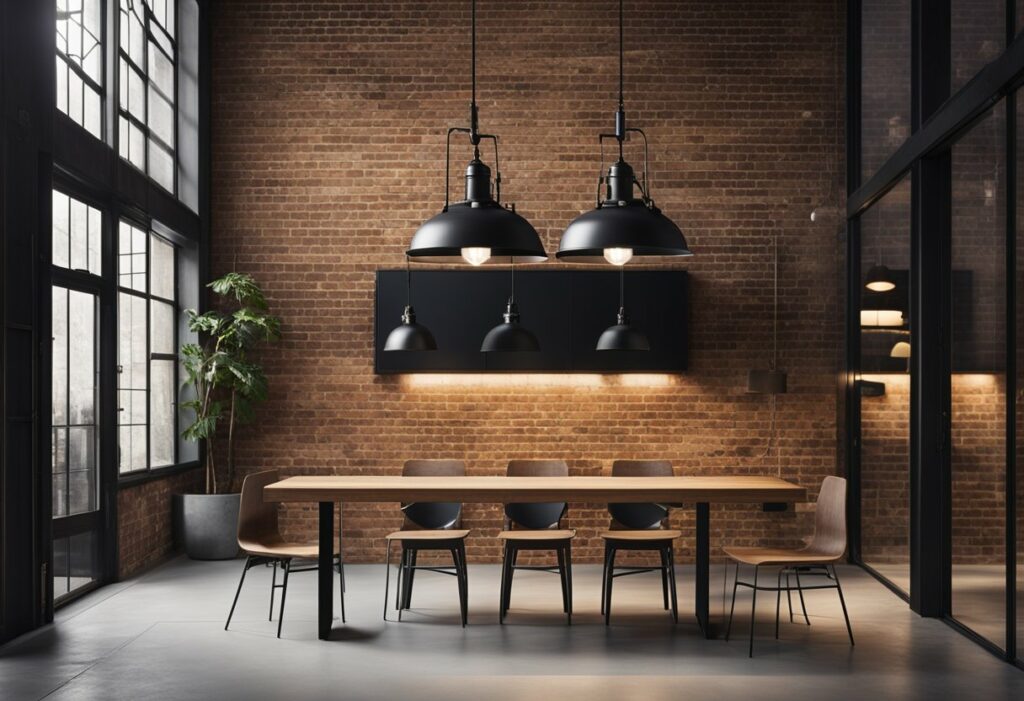
What are the defining characteristics of an industrial style living space?
Industrial style living spaces are known for their raw and unfinished look. The style is inspired by industrial spaces such as factories and warehouses. Exposed brick walls, concrete floors, and metal accents are some of the defining characteristics of an industrial style living space. The use of neutral colours such as black, white, and grey is also common in this style.
How can one incorporate modern decor into an industrial style interior?
Incorporating modern decor into an industrial style interior can be done by adding contemporary furniture and decor pieces. For example, you can add a modern sofa or a sleek coffee table to your industrial living space. You can also add modern artwork or a statement lighting fixture to give your space a modern touch.
Which materials are quintessential for achieving an authentic industrial aesthetic?
Materials such as metal, concrete, and wood are quintessential for achieving an authentic industrial aesthetic. Exposed pipes and ductwork can also add to the industrial look. The use of reclaimed materials such as old wood or metal can also add character to an industrial space.
What innovative ideas can transform a bedroom into an industrial design haven?
To transform a bedroom into an industrial design haven, you can add an industrial-style bed frame or a metal headboard. You can also add a vintage rug or an industrial-style pendant light to the space. Adding metal accents such as a metal side table or a metal chair can also add to the industrial aesthetic.
Can you merge industrial style with other interior design styles, and how?
Yes, you can merge industrial style with other interior design styles. For example, you can merge industrial style with Scandinavian design by adding cozy textiles such as fur throws or sheepskin rugs. You can also merge industrial style with bohemian design by adding colorful textiles and plants to the space.
What are the historical influences that have shaped industrial interior design?
Industrial interior design finds its origins in the industrial revolution. The rise of urbanization and the use of new technologies and materials during this time period influenced the industrial aesthetic. The Bauhaus movement and the Arts and Crafts movement also had an influence on the development of industrial interior design.


